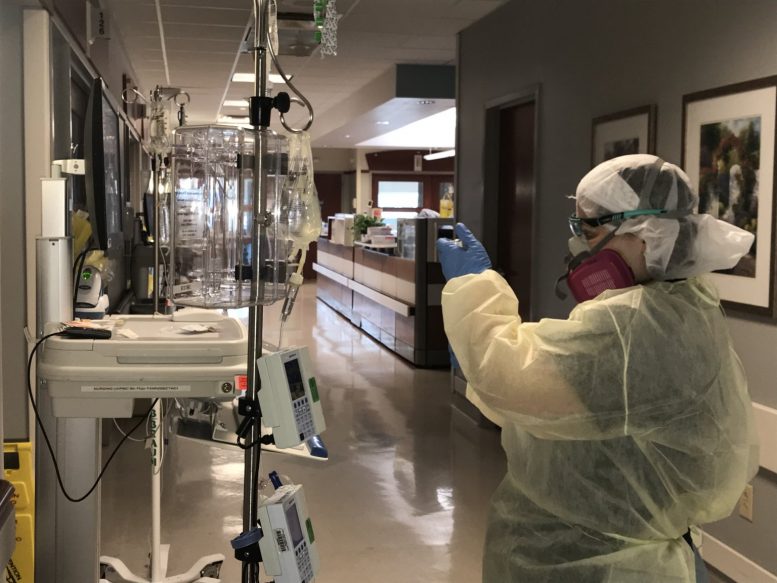The Ohio Legislature spurned the medical community and aligned itself with anti-vaccine groups Thursday, sending to Gov. Mike DeWine legislation that scuttles the state health department’s quarantine powers.
In a party line vote, House Republicans passed Senate Bill 311, which prohibits the Ohio Department of Health from issuing statewide and regional quarantine or isolation orders to people who haven’t been infected or exposed to disease. The Senate passed the bill in September.
State Rep. Haraz Ghanbari (R-Perrysburg) and State Sen. Theresa Gavarone (R-Bowling Green) are both co-sponsors of the legislation. BG Independent editor’s note.
It would also allow lawmakers to pass a resolution to rescind ODH orders like the statewide mask mandate.
The passage comes as the pandemic reaches new heights in Ohio. There are more than 3,700 Ohioans in the hospital with COVID-19 as of Wednesday, triple what it was just one month prior. New infections are surging at breakneck pace, and the death toll is likely to hit 6,000 this week.
In a hastily arranged committee hearing Thursday morning, ODH Chief Medical Officer Bruce Vanderhoff urged lawmakers to vote down SB 311.
“The legislation takes away public health’s ability to be nimble in the response to the COVID-19 pandemic and will limit the ability of public health officials to respond to future infectious disease outbreaks and potential acts of bioterrorism,” he said.
The Ohio Hospital Association, Ohio State Medical Association, the state chapter of the American Academy of Pediatrics, and the Ohio Children’s Hospital Association, jointly wrote a letter urging against passage.
“While we are currently experiencing unprecedented increases in COVID-19 cases and new daily records of hospitalizations and ICU stays, we would urge the Ohio Legislature rethink passing this legislation as this time,” the hospitals wrote. “A proposal like SB 311 will not help Ohio stem the rising COVID-19 case numbers, hospitalizations, ICU admissions, and deaths occurring as a result of this pandemic.”
The passage likely sets up a showdown with between the General Assembly and DeWine, who threatened to veto the legislation.
“This bill would make Ohio slow to respond to a crisis, it would take tools away from this governor or future governor, it would put the lives of Ohioans in jeopardy,” DeWine, also a Republican, said to reporters.
“This bill is a disaster.”
The legislation passed the Senate with a veto-proof 20-13 vote. It passed the House with a 58-30 vote. Several Republicans were absent from the vote and could potentially give the House Republican caucus a veto-proof majority in that chamber as well.
Current state law gives the ODH director “ultimate authority” in matters of quarantine and isolation. It also allows the department to issue orders “for preventing the spread of contagious disease.”
The legislation doesn’t automatically repeal any coronavirus-related public health orders. However, it holds the door open for lawmakers to strike down orders as they see fit.
House Republicans said the legislation is less about health policy than separation of powers. They took issue with the health department passing ordinances like a stay-at-home order in March or a mask mandate in July without any legislative oversight.
“It’s the constitutional issue that bothers us more than the health issue,” said Rep. Jason Stephens, R-Kitts Hill.
Rep. Reggie Stoltzfus, R-Minerva, said this bill is about ignoring the experts and trusting Ohioans — not the government — to make sound decisions.
“This bill is about checks and balances,” he said.
In an interview after the session, House Speaker Bob Cupp said Ohio’s hospital and medical associations failed to prove how SB 311 will worsen COVID-19 case counts or hospital loads.
“They have really not shown how this legislation is going to worsen any of that,” he said.
The bill would allow the Legislature to rescind the statewide mask mandate, but Cupp referred to the idea as “speculating three times down the road.”
Democrats, who have found themselves in an unusual lockstep with DeWine, said this isn’t the time for a power struggle.
“Now is not the time to argue who gets to make these decisions,” said Democratic Rep. Beth Liston, who is also a physician.
In fielding proponent testimony on the legislation, troves of Ohioans affiliated with two anti-vaccine groups in the state lined up to speak in support of the legislation.
Michelle Cotterman, president of Health Freedom Ohio, an anti-vaccine (members prefer the term “medical freedom”) group, said COVID-19 orders caused increases in drug abuse and suicide far worse than the pandemic itself.
“We are also concerned with the practice of solely relying on individuals trained in pharmaceutical-based health care and medical trade organizations when shaping public health policy,” Cotterman said.
The specific effects of the legislation are unclear.
Micah Berman, a public health law professor at Ohio State University, said the legislation doesn’t define “quarantine” or “isolation” and that it’s unclear whether a stay-at-home order counts as a quarantine.
“It strikes me as bad lawyering and bad legislative drafting,” he said. “I don’t know how a court could possibly make sense of what this bill says.”
The issue arose during committee Thursday morning. An attorney with the nonpartisan Legislative Service Commission emailed lawmakers during the hearing to say she “cannot opine as to whether a court would consider the April Stay Home orders as an isolation or quarantine.”
Also, the legislation would prevent ODH from quarantine those who have not been exposed to a disease. But more than 7,000 Ohioans are testing positive on average for COVID-19 per day on average, a figure that’s rising. Contact tracers are backlogged tracking exposures, muddying the picture of who has or has not been exposed.
Elsewhere in the Capitol on Thursday, the new coronavirus once again pierced the Statehouse bubble.
House Civil Justice Committee Chairman Stephen Hambley, R-Brunswick, told members that within an hour of the hearing starting, a staffer had tested positive for COVID-19.
“I’m asking all members and staff to please take the abundance of common caution,” he said. “Masks, distance, sanitation and so forth.”
House Republicans went on to vote down an attempt from Democrats to require members and staff to wear masks in the chamber. Many (not all) House Republicans still refuse to wear mask, despite a scientific consensus that they reduce the risk of the wearer spreading the virus if he or she does not have symptoms.
The CDC also recently updated its mask guidance to reflect new evidence suggesting they protect the wearer from contracting COVID-19.
“I don’t think I can order other elected officials to wear masks,” Cupp said.
Susan Tebben and Tyler Buchanan contributed to this report.
***
“This is not a drill.” Health officials say they might have to start canceling procedures
Coronavirus cases in Ohio continue to snowball and now health officials say the strain is so great that any day now they might have to start canceling medical procedures.
They made that stark warning on a day when the state’s GOP lawmakers seemed to be living in another world, with House Republicans voting down a mask mandate in the Capitol and granting its approval to a Senate measure that would greatly reduce the governor’s power to impose orders in health emergencies such as the pandemic.
Incomplete data released Thursday showed that at 7,787, the number of new cases reported over the past 24 hours continues a weeklong trend of days in which new cases are near the state record of 8,071 that was reported last week.
More alarmingly, there were 343 new hospitalizations due to covid. That’s less than the record 386 reported nine days ago, but when patients are admitted to the hospital for coronavirus, they tend to stay for relatively long periods. So when there are extended stretches of days with high admissions, hospitals run out of beds. READ MORE
This time-lapse shows the alarming spread of COVID-19 throughout Ohio
The spread of coronavirus is evident all throughout Ohio as the state heads into the winter months.
All 88 counties have “high incidence” of spread, as defined by the Centers for Disease Control and Prevention. The state’s Public Health Advisory System map, which labels the 88 counties by various spread indicators, shows an alarming trend since September.
This map is produced by the Ohio Department of Health and is updated each week. Here is a time-lapse of the map over the recent months: READ MORE
Ohio House Republican unloads COVID-19 conspiracy theories to Senate committee
There’s a whole story to tell about COVID-19 beyond just the “scary” stuff the Ohio Department of Health releases every day, said Rep. Diane Grendell.
It’s time for ODH to tell both sides of the story regarding the pandemic that has killed more than 250,000 Americans, according to the Geauga County Republican, not just the “one-sided” items like deaths, hospitalizations, and infections.
“We believe the data has been corrupted,” she said to the Senate Government Organization Committee on Wednesday.
“The CDC is in the process of going through every COVID-19 case and only three states have such, what they call, corrupt data: New York, Kentucky and Ohio.”
In an interview, Grendell, said she learned this information via one source inside the CDC and one source outside the agency. She declined to identify them. She said the investigation has to do with ODH’s case definition of COVID-19 but offered no further details. READ MORE





